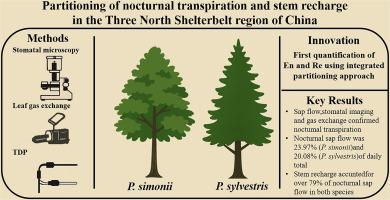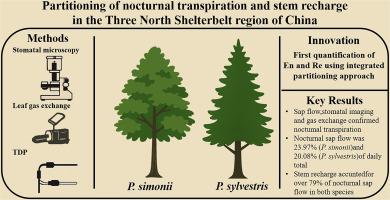Partitioning of nocturnal transpiration and stem recharge in the Three North Shelterbelt region of China
IF 5.7
1区 农林科学
Q1 AGRONOMY
引用次数: 0
Abstract
In arid and semi-arid regions, nocturnal water use in trees plays a critical role in regulating forest hydrology and maintaining plant water equilibrium. However, the physiological partitioning of nocturnal sap flow (NSF) into nocturnal transpiration (En) and stem recharge (Re), as well as their environmental regulation, remains inadequately characterized. This study aimed to investigate the characteristics and regulatory mechanisms of NSF in Populus simonii Carr. and Pinus sylvestris var. mongolica Litv., two dominant afforestation species in the Three North Shelterbelt region of northern China. Using thermal dissipation probes (TDP), we determined that NSF accounted for 23.97 % and 20.08 % of the total daily sap flow (Q) in P. simonii and P. sylvestris, respectively. The average nocturnal flow velocities () were 2.71×10⁻⁴ and 1.51×10⁻⁴ cm·s⁻¹, respectively. Leaf gas exchange measurements confirmed a low, yet non-negligible, nocturnal transpiration (: 0.04–0.12 mmol H₂O·m⁻²·s⁻¹), and stomatal conductance (: 0.06–0.15 mmol H₂O·m⁻²·s⁻¹), supported by quantitative stomatal imaging, demonstrating partial nocturnal aperture (18.6 % in P. simonii, 12.4 % in P. sylvestris). Path analysis revealed that VPD and SWC jointly regulated NSF. A VPD-based exponential decay model estimated that Re accounted for over 79 % of in both species, signifying that stem recharge is the dominant component of nocturnal water movement. Our findings suggest that NSF is an active physiological process characterized by species-specific traits and environmental sensitivity. Accurate quantification and modeling of En and Re are essential for improving forest water-use strategies in the context of climate change.


中国三北防护林夜间蒸腾和树干补给的分配
在干旱半干旱地区,树木夜间水分利用在调节森林水文和维持植物水分平衡中起着至关重要的作用。然而,夜间液流(NSF)在夜间蒸腾(En)和茎干补给(Re)中的生理分配及其环境调控仍未得到充分的研究。本研究旨在探讨西孟杨(Populus simonii Carr) NSF的特征及其调控机制。和蒙古松。是中国北方三北防护林地区的两种优势造林树种。利用热耗散探针(TDP)测定,NSF分别占simonii和sylvestris总日液流量(Q)的23.97%和20.08%。平均夜间血流速度(VnVn)分别为2.71×10⁻⁴和1.51×10⁻⁴cm·s⁻¹。叶片气体交换测量证实了一个低的,但不可忽略的夜间蒸腾(TrTr: 0.04-0.12 mmol H₂O·m⁻²·s⁻¹)和气孔导度(ggs: 0.06-0.15 mmol H₂O·m⁻²·s⁻¹),在定量气孔成像的支持下,显示了部分夜间气孔(P. simonii 18.6%, P. sylvestris 12.4%)。通径分析显示VPD和SWC共同调控NSF。基于vpd的指数衰减模型估计,在这两个物种中,Re占QnQn的79%以上,这表明茎干补给是夜间水分运动的主要组成部分。研究结果表明,NSF是一个具有物种特异性和环境敏感性的活跃生理过程。准确量化和模拟En和Re对于改善气候变化背景下的森林水资源利用战略至关重要。
本文章由计算机程序翻译,如有差异,请以英文原文为准。
求助全文
约1分钟内获得全文
求助全文
来源期刊
CiteScore
10.30
自引率
9.70%
发文量
415
审稿时长
69 days
期刊介绍:
Agricultural and Forest Meteorology is an international journal for the publication of original articles and reviews on the inter-relationship between meteorology, agriculture, forestry, and natural ecosystems. Emphasis is on basic and applied scientific research relevant to practical problems in the field of plant and soil sciences, ecology and biogeochemistry as affected by weather as well as climate variability and change. Theoretical models should be tested against experimental data. Articles must appeal to an international audience. Special issues devoted to single topics are also published.
Typical topics include canopy micrometeorology (e.g. canopy radiation transfer, turbulence near the ground, evapotranspiration, energy balance, fluxes of trace gases), micrometeorological instrumentation (e.g., sensors for trace gases, flux measurement instruments, radiation measurement techniques), aerobiology (e.g. the dispersion of pollen, spores, insects and pesticides), biometeorology (e.g. the effect of weather and climate on plant distribution, crop yield, water-use efficiency, and plant phenology), forest-fire/weather interactions, and feedbacks from vegetation to weather and the climate system.

 求助内容:
求助内容: 应助结果提醒方式:
应助结果提醒方式:


